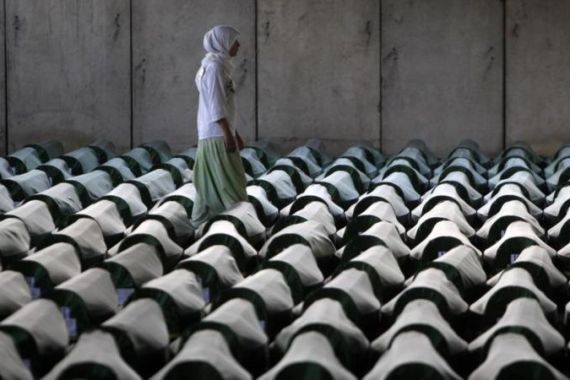Twenty years of genocide denial
On the anniversary of the Srebrenica massacre, healing the war’s wounds must be a priority.

As Srebrenica was overrun by Bosnian Serb forces in July 1995, Mohamed Durakovic escaped into a nearby forest. But the enemy was waiting in the woods. Serb soldiers told the fleeing civilians that it was safe to surrender – then shot them dead.
“One of the biggest struggles was convincing my father, who was walking with me, not to turn himself in,” recalled Durakovic. “His best friends were Serbs, and he was convinced they would spare civilians.”
Keep reading
list of 4 itemsICJ updates: Nicaragua’s case against Germany over Israel’s war on Gaza
The judicial legacy of the Rwandan genocide: 30 years of double standards
Rwanda genocide: ‘Frozen faces still haunt’ photojournalist, 30 years on
It seems that the trust which had bound Bosnia’s communities together had not entirely been eradicated, even after three years of war, when the genocide at Srebrenica took place.
But trust has yet to emerge in the years after the conflict, which have been characterised by a shameful refusal to face the truth.
|
|
This year brings the 20th anniversary of the genocide at Srebrenica and the end of the Bosnian war. It also marks 20 years of genocide denial.
Confronting the past
Bosnia-Herzegovina sporadically confronts its past only in court hearings – not in official policies, laws, school curricula or structural reforms.
It is a society where victims’ needs for justice, truth and reparation are ignored, and their loss and suffering are abused by ethno-nationalist political agendas.
Generations are going to school here without a single lesson or textbook that will tell them of the crimes committed in their schoolyard or in the woods surrounding their hometown. Denial has become the natural law of co-existence.
So, what is it that some deny? On July 10-11, 1995, the Bosnian Serb army attacked Srebrenica, a designated UN “safe area”, and executed more than 8,000 Bosnian Muslim men and boys. The practical nature of the process, and its horrific outcome, point to a well-planned operation serving a genocidal intent.
Acknowledging the truth about the war is the first step to restoring trust. Re-burying the dead does not mean we can remain in denial.
The International Criminal Tribunal in The Hague, the International Court of Justice and the state court of Bosnia-Herzegovina have established it as such – genocide. What some deny ever happened is the only atrocity in Europe to be labelled genocide since World War 2.
Culture of denial
Actually, denial was the first reaction to the massacre – as the perpetrators of the crimes in Srebrenica dug up the primary mass graves, and moved the bodies into secondary and tertiary mass graves.
At times, they even burned the bodies. From then onwards, it was easier to deny what had occurred. When the remains were found, the denial took another form – it was claimed that those killed were legitimate military targets.
This argument is still being used, even though 421 child victims have been re-buried so far, one of them a new-born baby, and even though the adults who were killed include a 94-year-old woman, Saha Izmirlic.
The bodies of more than 7,000 victims of the Srebrenica genocide have been exhumed, identified and re-buried at a memorial. But the majority of those responsible for genocide and war crimes enjoy impunity. Meanwhile, the survivors of Srebrenica and the relatives of the dead wait for justice, truth and reparation.
Every year on July 9, trucks carrying the remains of newly identified victims drive through the main street of Sarajevo. They make a brief stop in front of the office of the Presidency of Bosnia-Herzegovina, where hundreds of mourners await. Some of the mourners throw flowers on the canvas covering the trucks. Some pray in silence.
Mourning the victims
Among the officials present are usually two of the three presidents of the country. The third president, representing the Serbian people, is traditionally absent. The trucks take the remains to the memorial, the crowd disperses, the officials walk back to their offices.
![Forensic anthropologist works to identify the remains of a victim of the Srebrenica genocide [REUTERS]](/wp-content/uploads/2015/07/2e49995524b643638f614cac71666349_18.jpeg)
One is left wondering: do any of the suited officials spend as much as a second thinking of their own responsibility towards the coffins that will be laid in the ground and towards the relatives who will mourn beside those coffins?
Do these elected officials think about the laws and programmes that could guarantee justice for those who have been tortured, raped or killed? Or do they just shed a tear and move on?
The Bosnian Serb wartime campaign caused untold misery but it did not achieve its genocidal objective. Muslims continue to live in Bosnia and Herzegovina. A handful have even returned to Srebrenica. The fate of the nation depends on cooperation between the communities – but the trust is gone.
“The new generation is far more nationalist than the old one,” said Durakovic. “I grew up living with kids from other nationalities. Kids growing up today have no idea of the other – they are separated into ethnically cleansed areas.”
Acknowledging the truth about the war is the first step to restoring trust. Re-burying the dead does not mean we can remain in denial.
“Healing needs to be done by speaking the facts,” said Durakovic. “This will lead to the truth.”
Sumeja Tulic is Amnesty International’s Bosnia researcher. She was part of an Amnesty International mission to Srebrenica in June 2015.
The views expressed in this article are the author’s own and do not necessarily reflect Al Jazeera’s editorial policy.
